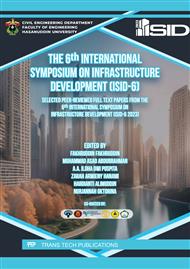p.3
p.13
p.21
p.37
p.47
p.57
p.65
p.75
p.83
Wave Characteristics Simulation in the Waters of Pesisir Barat Lampung with the Wind Data Approach of the Bengkulu Recording Station
Abstract:
Wind data is very necessary in estimating wave height at sea, especially in areas that do not yet have wave data recorded. This research aimed to determine the characteristics of waves in the western waters of Lampung, as well as compare the results of wind data simulations of the Lampung recording station with those in Bengkulu. The results of wind data processing and geographic position would determine the dominant wind direction, retrieval length, and several variables characteristic of ocean waves. The results of the analysis showed the dominant wave generation direction towards the South on the west coast, with a minimum wave height of 0.95m a maximum of 4.3m, and a wave period of up to 11 seconds. The wave broke out at a height of 1.571m depth of 1.49m according to calculations. The average wave rupture occurred at a depth of 1.49m with a wavelength of 1.571m with an average Ks value of 0.53 and an average Kr value of 0.85. The simulation results concluded that wave height using wind data from the Bengkulu recording station had a greater value than using wind data from the Lampung recording station.
Info:
Periodical:
Pages:
47-56
Citation:
Online since:
July 2025
Authors:
Keywords:
Price:
Сopyright:
© 2025 Trans Tech Publications Ltd. All Rights Reserved
Share:
Citation:


